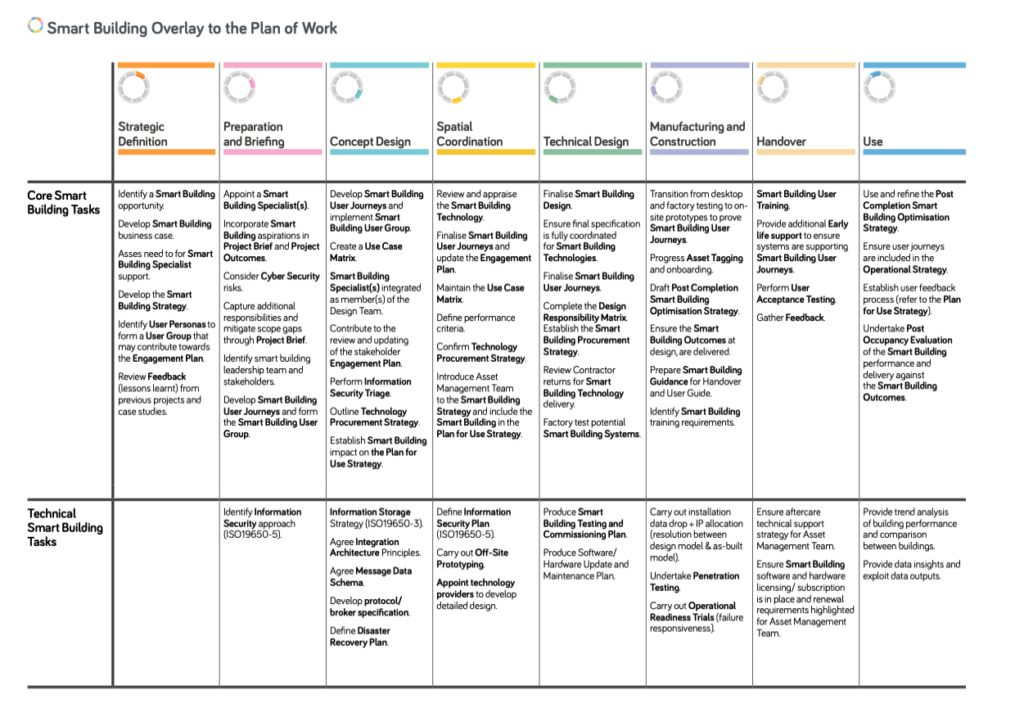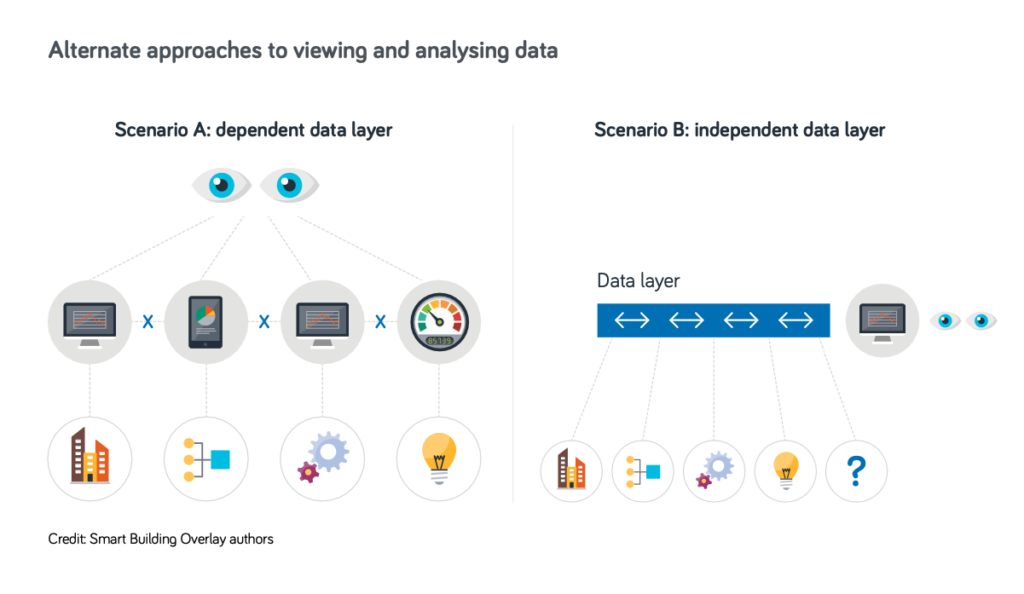The Royal Institute of British Architects (RIBA) has created a Smart Building Overlay to the 2020 RIBA Plan of Work, which clearly defines the stages of development in building projects.
This Smart Building Overlay acts as a resource for all built environment professionals, clients and end users, looking for guidance on how to incorporate smart building technology in any building typology.
“The Smart Building Overlay discusses innovative approaches to support opportunities for Smart Building Technology in any building typology, within the framework of the RIBA Plan of Work,” the organization explained. “It addresses the crossover of technology, sustainability and the built environment with principles that may be applied to any project.”
The clear priority of RIBA’s Smart Building Overlay is to improve information handover between stakeholders in the various phases of a building project and ensure that smart technology concepts are incorporated during the design phase. We have been discussing these fragmented data silos and the design-construct-operate divide for over a decade in the smart building industry, so its prioritization by an important global institute is very encouraging.
“Our research shows that, too often, the decision to include smart technology in a project is often made too late. So, this guide prompts the client and project team to integrate smart technology discussions at every stage of design and construction,” said RIBA President, Muyiwa Oki. “It recommends involving specialists at the earliest possible stage to ensure successful project outcomes.”
RIBA’s Smart Building Overlay

The 2024 overlay guidance to RIBA’s 2020 Plan of Work provides an understanding of the specific requirements and considerations needed in the design and construction phase to have the best chance of a successful operations phase. As such, the overlay offers recommendations in 8 stages along the timeline of a smart building project:
Stage 0 - Strategic Definition
In Stage 0, RIBA acknowledges that smart building intentions may not be in place yet, but emphasizes that a Smart Building project should always be based on a solid business case or specific client aspiration. It describes Stage 0 as the ideal time to start understanding user personas, user journeys and critical dependencies, as well as whole lifecycle cost and stakeholder engagement.
Stage 1 - Preparation and Briefing
By Stage 1 there should be high-level agreement that a Smart Building is desirable and aligns with the identified needs of the client, the building operator/owner, and end user. In this stage, the project may choose to appoint a smart building specialist to further define user journeys and personas.
Alongside stakeholders, the specialists will help develop a clear project brief and define outcomes, while also considering cybersecurity risks and other critical aspects.
Stage 2 - Concept Design
As the design starts to develop, the strategy for how passive or active the technology should be considered in Stage 2. According to RIBA, the key to success in this stage is to form a deep understanding of end users, smart technology, and the proposed functions of different spaces within the building.
This stage also includes the creation of a use case matrix, an information storage strategy (IS019650-3), integration architecture principles, message data schema, protocol/broker specification, and a disaster recovery plan.

Stage 3 - Spatial Coordination
In Stage 3, the project finalizes key planning processes such as user personas and journeys within the use case matrix, stakeholder engagement plan, and technology performance criteria. This stage also sees the development of an asset management team, technology procurement strategy, information security plan (IS019650-5) and the selection of smart technology providers.
Stage 4 - Technical Design
The completion of the smart building’s technical design and definition of required standards, processes, specifications, and methodologies comes about in Stage 4, alongside the appointment of a master systems integrator (MSI). Prior to construction phases, the team must create a design responsibility matrix, a testing and commissioning plan, as well as an update and maintenance plan for hardware and software.
“With Smart Building Technology rapidly evolving, decisions on final specification of hardware and software may have been postponed for as long as possible: Stage 4 is the final opportunity to make these choices so that detailed design, detailed coordination and procurement can take place along with any statutory applications ahead of construction works; all of this must be completed in order to conclude Stage 4,” RIBA’s guidance reads.
Stage 5 - Manufacturing and Construction
As construction begins, the focus is on information management under a “golden thread” approach to ensure any modifications to the design are recorded and implications considered. In Stage 5, installation data drops and IP allocation must take place alongside penetration testing and operational readiness trials, as well as smart building training plans.
RIBA recommends asset testing, prototyping, and tagging takes place in a factory setting in coordination with the room naming strategy to ensure physical device locations match exactly with any data provided by the asset tag. Before handover, it must be ensured that smart building design outcomes are delivered by construction teams and a post-completion smart building optimization strategy is drafted.
Stage 6 - Handover
Stage 6 is all about a smooth transition from design and construction to operational teams through user training and the provision of “early life-support”. This phase hinges in user acceptance training and feedback that could demand adjustments to the smart technology ecosystem. Handover also establishes aftercare for asset management teams and ensures all licensing and subscriptions are in place, with renewal requirements highlighted.
Stage 7 - Use
Once in use, the building will begin to generate data, occupants will begin to provide feedback, and the project team should undertake post-occupancy evaluation of the building’s performance and delivery against the smart building outcomes. RIBA recommends tuning and monitoring over at least 15 months to ensure there is a minimum of three months of baseline data, plus 12 months to allow all seasonal impacts to be considered.
“Although the stages place emphasis on the delivery of a new or refurbished asset, the process is circular underlining the importance of how a building adapts during its life as part of circular economy principles,” RIBA clarifies. “As Stage 7 nears its end, a client will use stage 0 to consider the next phase of a building’s life from light touch updates to demolition, although the latter is increasingly being discouraged to reduce the embodied carbon associated with each iteration.”
Impact of RIBA’s Smart Building Overlay
RIBA's free Smart Building Overlay to its already well-established Plan of Work for building projects feels like a big step for the standardization of smart building processes.
Such guidance can act as an important framework to help smart building projects avoid the common pitfalls of the design-build-operate divide, as well as the associated costs and delays.
For the smart buildings market, a focus on information handovers between project phases by a reputable building design-related institute represents hope for a more cohesive smart building development landscape in the not-so-distant future.
“The main objective of the Smart Building Overlay is to prompt discussions of smart building technology at each work stage to support timely decisions, so that the project aspirations articulated at the outset are delivered at completion,” RIBA concludes. “It encourages users to consider how the technology might support their desired project outcomes and helps them define ‘how smart’ they want their project to be.”



